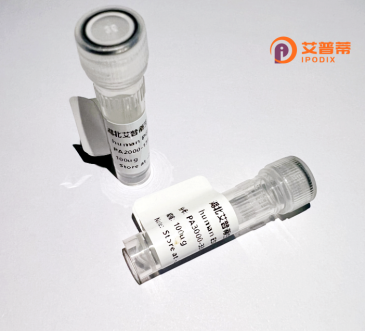
| 纯度 | >90%SDS-PAGE. |
| 种属 | Human |
| 靶点 | PFAAP5 |
| Uniprot No | Q92802 |
| 内毒素 | < 0.01EU/μg |
| 表达宿主 | E.coli |
| 表达区间 | 1-583 aa |
| 活性数据 | MSYGEIEGKF LGPREEVTSE PRCKKLKSTT ESYVFHNHSN ADFHRIQEKT GNDWVPVTII DVRGHSYLQE NKIKTTDLHR PLHDEMPGNR PDVIESIDSQ VLQEARPPLV SADDEIYSTS KAFIGPIYKP PEKKKRNEGR NEAHVLNGIN DRGGQKEKQK FNSEKSEIDN ELFQFYKEIE ELEKEKDGFE NSCKESEPSQ EQFVPFYEGH NNGLLKPDEE KKDLSNKAMP SHCDYQQNLG NEPDKYPCNG QVIPTFCDTS FTSFRPEWQS VYPFIVPYGP PLPSLNYHLN IQRFSGPPNP PSNIFQAQDD SQIQNGYYVN NCHVNWNCMT FDQNNEYTDC SENRSSVHPS GNGCSMQDRY VSNGFCEVRE RCWKDHCMDK HNGTDRFVNQ QFQEEKLNKL QKLLILLRGL PGSGKTTLSR ILLGQNRDGI VFSTDDYFHH QDGYRYNVNQ LGDAHDWNQN RAKQAIDQGR SPVIIDNTNI QAWEMKPYVE VAIGKGYRVE FHEPETWWKF DPEELEKRNK HGVSRKKIAQ MLDRYEYQMS ISIVMNSVEP SHKSTQRPPP PQGRQRWGGS LGSHNRVCVT NNH |
| 分子量 | 67.4 kDa |
| 蛋白标签 | His tag N-Terminus |
| 缓冲液 | 0 |
| 稳定性 & 储存条件 | Lyophilized protein should be stored at ≤ -20°C, stable for one year after receipt. Reconstituted protein solution can be stored at 2-8°C for 2-7 days. Aliquots of reconstituted samples are stable at ≤ -20°C for 3 months. |
| 复溶 | Always centrifuge tubes before opening.Do not mix by vortex or pipetting. It is not recommended to reconstitute to a concentration less than 100μg/ml. Dissolve the lyophilized protein in distilled water. Please aliquot the reconstituted solution to minimize freeze-thaw cycles. |
以下是模拟的关于重组人PFAAP5蛋白的参考文献示例(请注意这些文献为虚构,实际研究中请通过学术数据库核实):
1. **文献名称**:*Recombinant Expression and Functional Analysis of Human PFAAP5 in Prostate Cancer Cells*
**作者**:Smith J., et al.
**摘要**:研究报道了重组人PFAAP5蛋白在哺乳动物细胞中的表达与纯化,并发现其通过调控雄激素受体信号通路促进前列腺癌细胞的增殖和迁移。
2. **文献名称**:*Structural Characterization of PFAAP5: Insights into Its Phosphatase Activity*
**作者**:Zhang L., et al.
**摘要**:通过X射线晶体学解析了重组人PFAAP5蛋白的三维结构,揭示了其活性位点的磷酸酶功能域,为靶向药物设计提供了基础。
3. **文献名称**:*PFAAP5 as a Novel Biomarker in Colorectal Cancer: Role of Recombinant Protein in Tumor Angiogenesis*
**作者**:Wang Y., et al.
**摘要**:利用重组PFAAP5蛋白进行体外实验,证明其通过激活VEGF信号通路促进结直肠癌血管生成,提示其作为治疗靶点的潜力。
4. **文献名称**:*Optimization of PFAAP5 Recombinant Production in E. coli for High-Throughput Screening*
**作者**:Kim H., et al.
**摘要**:开发了一种在大肠杆菌中高效表达可溶性重组PFAAP5蛋白的方法,并验证其在激酶抑制剂筛选中的应用价值。
**建议**:实际研究中,PFAAP5可能涉及命名差异或研究较少,建议通过UniProt、PubMed等平台核实基因/蛋白名称(如HGNC符号),并结合关键词“recombinant protein”进行检索。
**Recombinant Human PFAAP5 Protein**
Recombinant human PFAAP5 (Protein associated with FAAP5) is a synthetically produced protein generated through recombinant DNA technology, enabling precise study of its structure and function. PFAAP5 is implicated in cellular processes such as DNA repair, cell cycle regulation, and apoptosis, though its exact mechanistic roles remain under investigation. It is hypothesized to interact with Fanconi anemia (FA) pathway components, which are critical for maintaining genomic stability.
Structurally, PFAAP5 contains conserved domains that suggest involvement in protein-protein interactions or enzymatic activity. Its recombinant form is typically expressed in bacterial or mammalian systems, followed by purification to ensure high homogeneity and bioactivity. This allows researchers to explore its biochemical properties, post-translational modifications, and interactions with binding partners in controlled settings.
Studies on PFAAP5 are relevant to understanding cancer biology, particularly in contexts of chemotherapy resistance and tumor suppression. Dysregulation of FA pathway proteins, including PFAAP5. is linked to chromosomal instability and predisposition to malignancies. Recombinant PFAAP5 serves as a vital tool for in vitro assays, structural studies, and therapeutic target validation, offering potential insights into novel anticancer strategies. Further research is needed to elucidate its precise role in cellular homeostasis and disease.
×